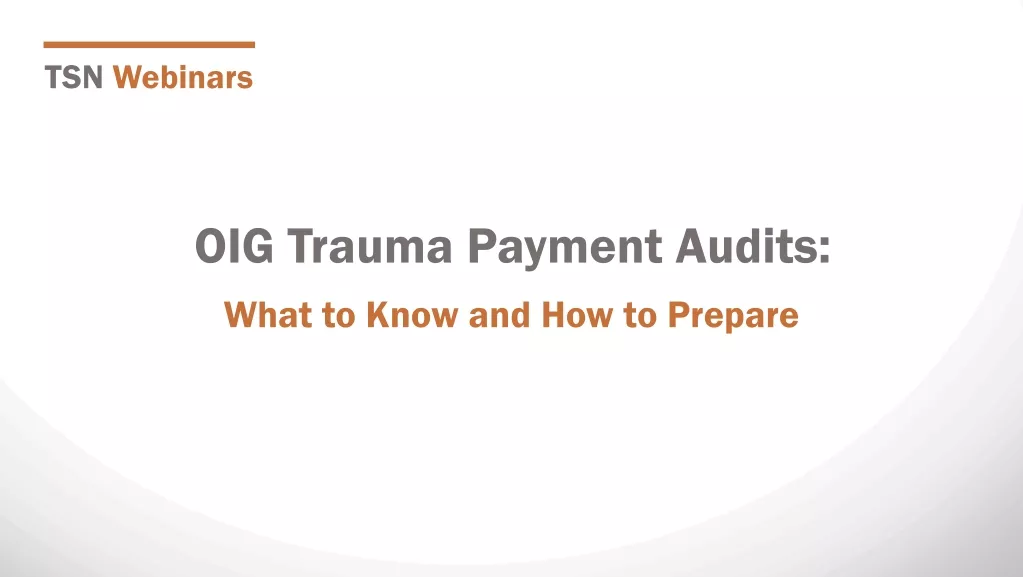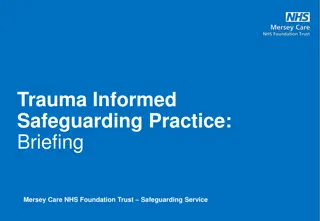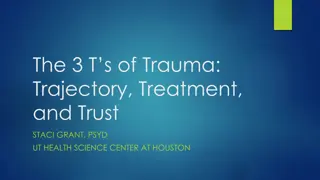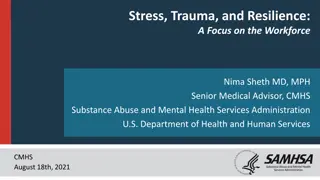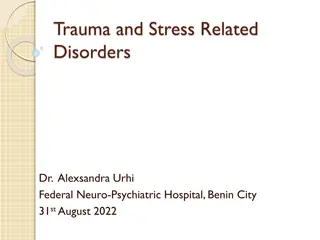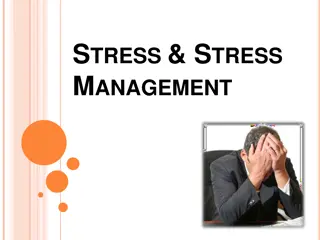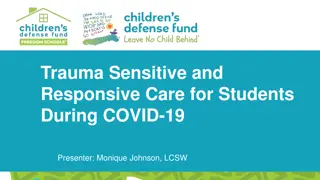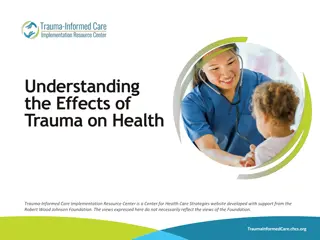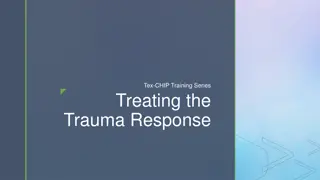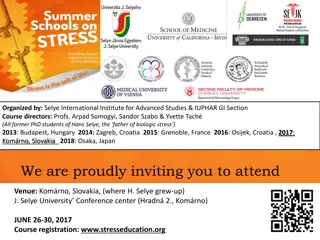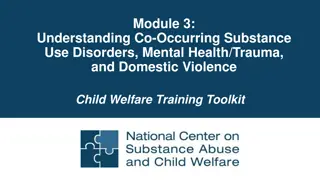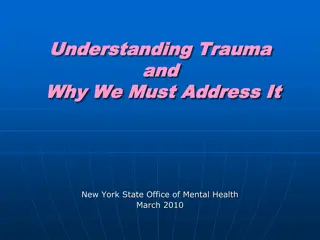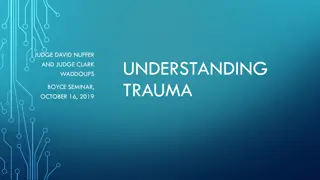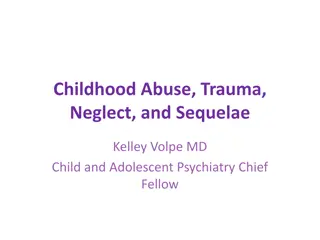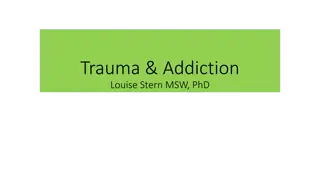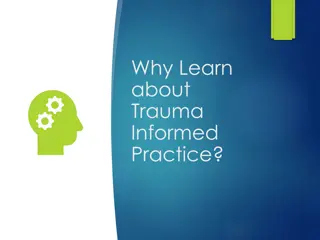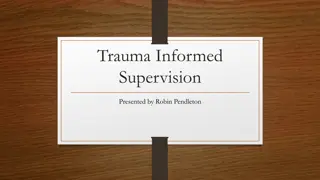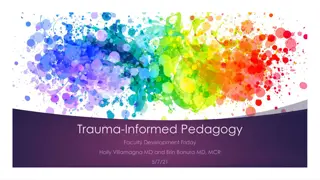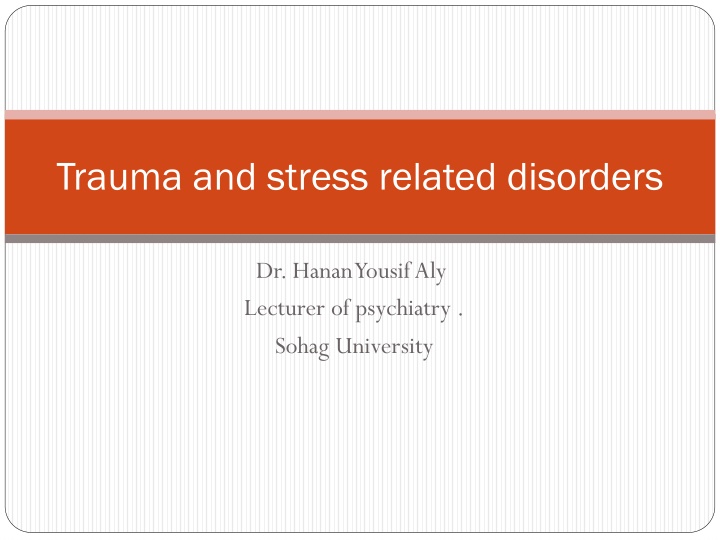
Trauma and Stress-Related Disorders in Psychiatry
Explore the definitions of stress, types of stressors, and classifications of trauma-related disorders like PTSD. Learn about eustress, distress, and criteria for post-traumatic stress disorder as discussed by Dr. Hanan Yousif Aly, a lecturer of psychiatry at Sohag University.
Uploaded on | 2 Views
Download Presentation

Please find below an Image/Link to download the presentation.
The content on the website is provided AS IS for your information and personal use only. It may not be sold, licensed, or shared on other websites without obtaining consent from the author. If you encounter any issues during the download, it is possible that the publisher has removed the file from their server.
You are allowed to download the files provided on this website for personal or commercial use, subject to the condition that they are used lawfully. All files are the property of their respective owners.
The content on the website is provided AS IS for your information and personal use only. It may not be sold, licensed, or shared on other websites without obtaining consent from the author.
E N D
Presentation Transcript
Trauma and stress related disorders Dr. HananYousifAly Lecturer of psychiatry . Sohag University
Definition of stress: Stress is the anxious or threatened feeling that comes when interpret or appraise the situation. (Lazarus.,1999)
Events or situations in our Stressors: environment that cause stress. Environmental: Heat, noise, crowding. Physiological: Drugs, caffeine, tobacco. Emotional (psycho-social): Pressures, life.
Eustress: Normal stress is necessary for an active, healthy life, increase mental and physical alertness and can enhance certain abilities . Distress: if the stress response is excessive or prolonged, it may eventually result in diseases,such as ulcers.
Classification: Posttraumatic stress disorder (PTSD), Acute stress disorder, and Adjustment disorders.
CRITERION A: CRITERION A: Exposure to traumatic event traumatic event Exposure to
Exposure to actual of threatened death, Exposure to actual of threatened death, serious injury, serious injury, or sexual violence in one or sexual violence in one ( (or more) or more) of the following ways of the following ways: Directly experiencing the traumatic event(s). Witnessing,
Learning that the traumatic event(s) occurred to a close family member or close friend.
Experiencing repeated or extreme exposure to unpleasant details of the traumatic event(s) (e.g.,first responders collecting human remains; police officers repeatedly exposed to the details of child abuse).
CRITERION B CRITERION B - - Intrusion Intrusion : :
Presence of one (or more) of the following intrusion symptoms associated with the traumatic event(s),beginning after the event(s) occurred: 1. Recurrent, involuntary, and intrusive distressing memories of the traumatic event(s) Note: In children older than 6 years, repetitive play may occur in which themes or aspects of the trauma are expressed.
2. Recurrent distressing dreams in which the content and/or affect of the dream are related to the traumatic event. Note: In children there may be frightening dreams without recognizable content.
Dissociative reactions (e.g., flashbacks) in which the 3. individual feels or acts as if the event(s) were recurring.
Intense or prolonged psychological 4. distress at exposure to internal or external cues that symbolize or resemble an aspect of the traumatic event(s). Marked physiological reaction to 5. external or internal cues that symbolize or resemble an aspect of the traumatic event(s)
CRITERION C CRITERION C Avoidance: Avoidance: Persistent avoidance of stimuli associated with the traumatic event(s),beginning after the traumatic event(s) occurred,as evidenced by one or both of the following:
1. Avoidance of or efforts to avoid distressing memories, thoughts, or feelings about or closely associated with the traumatic event(s).
2. Avoidance of or efforts to avoid external reminders (people, places, conversations, activities, objects, situations) that arouse distressing, memories, thoughts, or feelings about or closely associated with the traumatic event(s).
CRITERION D CRITERION D Negative alterations in Negative alterations in cognition & Mood. cognition & Mood. Negative alterations in cognitions and mood associated with the traumatic event(s), beginning or worsening after the event(s) occurred, as evidenced by two or more of the following:
1. Inability to remember an important aspect of the traumatic event(s) typically due to dissociative amnesia and not to other factors such as head injury, alcohol or drugs.
2- Persistent and exaggerated negative beliefs or expectations about oneself, others,or the world (e.g., I am bad, No one can be trusted, The world is completely dangerous, My whole nervous system is permanently destroyed ).
3- Persistent, distorted cognitions about the cause or consequences of the traumatic event(s) that leads the individual to blame himself/herself or others. 4- Persistent negative emotional state (e.g., fear, horror,anger,guilt,or shame).
5- Marked diminished interest or participation in significant activities. 6- Feelings of detachment from others 7- Persistent inability to experience positive emotions (e.g., happiness, satisfaction,or loving feelings).
CRITERION E CRITERION E Arousal & Arousal & Reactivity Reactivity Marked alterations in arousal and reactivity associated with the traumatic event(s), beginning or worsening after the traumatic event(s) occurred, as evidenced by two or more of the following:
1. Irritable behavior and angry outbursts expressed as verbal or physical aggression toward people or objects.
6. Sleep disturbance (e.g. problems falling or staying asleep or restless sleep).
Criteria A Exposure Criterion E. Arousal & Reactivity Criterion D. Negative Cognitions and Mood Criterion B. Intrusion Criterion C. Avoidance
Criterion F: Duration of the disturbance (Criteria B, C, D, and E) is more than 1 month. Criterion G: distress or impairment in social, occupational, or other important areas of functioning. The disturbance causes clinically significant Criterion H: physiological effects of a substance (e.g., medication or alcohol) or other medical condition. The disturbance is not attributable to
Acute Stress Disorder Acute Stress Disorder The essential feature of acute stress disorder is the development of characteristic symptoms lasting from 3 days to 1 month following exposure to one or more traumatic events
Adjustment Disorders Adjustment Disorders A- The development of emotional or behavioral symptoms in response to an identifiable stressor(s) occurring within 3 months of the onset of the stressor(s).
Adjustment Disorders Adjustment Disorders In adjustment disorders, the stressor can be of any severity rather than of the severity in PTSDs. The stressor may be a single event (e.g., a termination of a romantic relationship), or there may be multiple stressors (e.g., marked business difficulties and marital problems)
Adjustment Disorders Adjustment Disorders Stressors may be recurrent (e.g., associated with seasonal business crises,unfulfilling sexual relationships) or continuous (e.g., a persistent painful illness with increasing disability,living in a crime-ridden neighborhood).
Adjustment Disorders Adjustment Disorders B.These symptoms or behaviors are clinically significant,as evidenced by one or both of the following: Marked distress that is out of proportion to the severity or 1. intensity of the stressor, Significant impairment in social, occupational, or other 2. important areas of functioning.
Adjustment Disorders Adjustment Disorders The stress-related disturbance does not meet the criteria for another mental disorder and is not merely an exacerbation of a preexisting mental disorder.
Adjustment Disorders Adjustment Disorders D.The symptoms do not represent normal bereavement. E. Once the stressor or its consequences have terminated, the symptoms do not persist for more than an additional 6 months.
Adjustment Disorders Adjustment Disorders With depressed mood: With anxiety: With mixed anxiety and depressed mood: With disturbance of conduct: With mixed disturbance of emotions and conduct: Unspecified:

